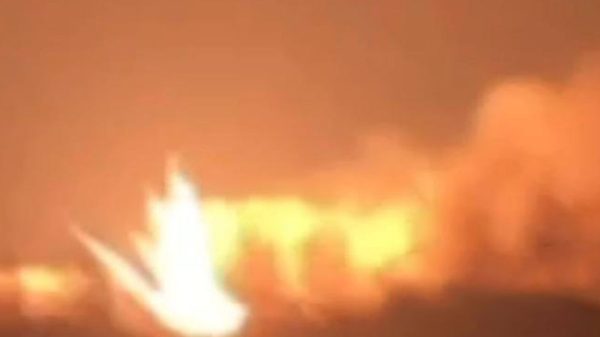Giant Carvings May Be Ancient Boundaries
Ancient cave paintings in what is now South America, believed to be among the largest in the world, were intended to mark the boundaries of territories in what is now South America, according to a new study. which their creators lived.

Birds, Amazonian centipedes, human figures and geometric shapes are among the designs found at 14 sites — most of which are already known, but there are also recently discovered — on a 97-kilometer stretch of the Orinoco River in the territory of modern Venezuela and Colombia, CNN reports.
However, the most common motif is giant snakes, and one in particular — in a place called Cerro Pintado in Venezuela — At about 138 feet (42 meters) long, it is likely the largest rock art discovered anywhere in the world, the researchers suggested.
“These territorial signs have two sides,— said Dr. Philip Riris, lead author of the study published Monday in the journal Antiquity. — One of them may be a warning sign — you're in our backyard, you better behave yourself. The other may be a sign of identity — you're in our backyard, you're among friends. But I don't think they had a single purpose, so they could easily be both.”
According to Riris, a senior lecturer in archaeological environmental modeling at Bournemouth University in the UK, the research focuses on the meaning and role that snakes play in the mythology of the indigenous peoples of the region. He believes that local people probably carved these stones between 1,000 and 2,000 years ago, based on pottery and motifs from that time found in the same area.
“The snakes are really interesting because they are both both creators and defenders. According to local mythology, they shape rivers as they travel, but they are also predators full of dangerous energy that must be treated with respect to avoid incurring their wrath.” notes Philip Riris, explaining why they can also have double meaning as cave paintings.
All of the snake paintings have a general visual consistency, and Riris believes they could have depicted boa constrictors or anacondas, although the artists were not necessarily interested in accurately representing certain species: «Indigenous people don't always differentiate between species the way we do in scientific systematics, — they may simply be large predatory snakes that kill by contracting,” — he said.
Human figures are often depicted next to snakes, as well as giant Amazonian centipedes that hunt snakes in the Orinoco. Geometric patterns include concentric circles, spirals and rectangles, but, according to Riris, their meaning is not entirely clear.
Dr Riris noted that the use of such ancient monumental inscriptions as territorial landmarks had been observed before, but Orinoco engravings stand out against the general background.
“What makes the Orinoco special is its size, its sheer quantity and density, and the lengths to which its creators had to go to create it”,— he said. Some of the rock formations they are carved into are «dangerous,» Riris added, noting that the artists may have had to use ropes or ladders to reach them.
The study was the result of data collected over 10 years of field work by Riris and his colleagues — co-authors Dr. José Oliver and Natalia Losada Mendieta, — although some of the study's results have been used for other studies. Oliver teaches Latin American archeology at University College London, and Losada Mendieta is assistant professor of art history at the University of Los Andes in Colombia.
The markings are located on a section of the river called the Atures rapids, which is known to have been an important trade and tourist route in prehistoric times. The team used special software to recreate the point of view of the ancient inhabitants and visualize how they would have perceived the markings.
Today, with the rapid growth of tourism, these sites may be at risk of vandalism, and the researchers registered them with the national authorities. heritage of Colombia and Venezuela, notes CNN.
“Fortunately, as far as we know, none of them were harmed, but as the number of people increases, they become more vulnerable,” comments Riris, adding that their protection should involve both the authorities and the indigenous people, who feel responsible for them.
"Ancient works give us a rare insight into how the indigenous people of Orinoco perceived their landscape and gave it a sacred character through rock art,” said George Lau, professor of art and archeology of the Americas at the University of East Anglia in the UK. He did not participate in the study.
“It also shows the long-term significance of such art to local landscapes, especially the importance of mythical creatures to local belief systems. The study is actually just the tip of the iceberg for the extremely rich archeology and ancient cultures of this region,” he added.
According to Dr. Alexander Gerds, associate professor of archeology of the Americas at the University of Oxford in the UK, this study is a key contribution to the understanding of rock art in northern South America. He also did not take part in the work.
According to Gerds, this study goes beyond earlier work in that it not only records the location and style of the carvings, but also deals with their unusual dimensions. He added that the use of computer visual analysis is innovative because it helps understand how the scale of the carvings compares to the ability to see them from afar — a likely scenario if indigenous groups traveled along the Orinoco River.
One of the key features of these large-scale carvings is the collective labor they required: “Especially on large rivers and river junctions, these may have been places where people came together to forge intercommunal ties in late pre-Hispanic times,” Gerds said. – In addition, the rapids (ironically) slow down the canoe's movement, creating a suitable platform for viewing the images. These monumental snakes are silent witnesses of the past social world”.


























































Свежие комментарии